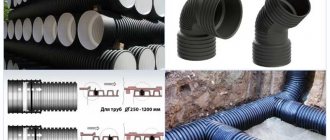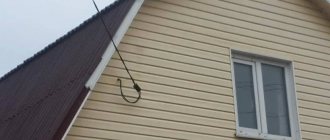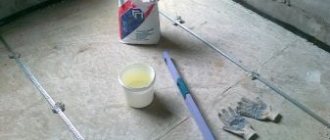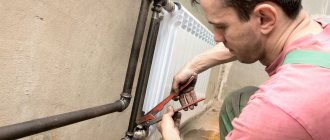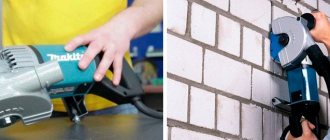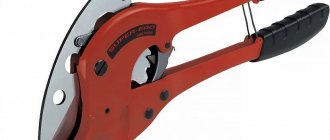People are accustomed to laying any communications underground. The explanation for this is very simple. The fact is that soil is a safer environment than air. Which pipe should I use for underground water supply? Builders often ask this question. The use of underground water pipes depends on many different factors.
The entire volume of passing groundwater is much less than the volume of precipitation, the impact of different temperatures is much weaker, and another plus is that underground pipes are much more difficult to damage than those laid on the surface.
Features of HDPE pipes
If you are planning to install a cold water supply system in your local area, I recommend using HDPE pipes. Low-pressure polyethylene pipes have a number of unique properties that are not available to their metal or concrete counterparts.
Advantages and disadvantages
The main quality of HDPE for external systems is ease of installation. Laying and assembling a water pipeline does not require special knowledge. In any hardware store you will find low-density polyethylene pipes of various diameters, sizes and wall thicknesses. In addition, HDPE products have the following features:
- Polyethylene does not react chemically with water transported through the water supply system. That is, the liquid entering the house will not contain impurities.
- HDPE pipes are 7 times lighter than metal products. This makes transportation and installation easier. When laying a water pipeline in a trench, it is not necessary to secure the network with additional supports.
- The smooth inner surface prevents the formation of blockages and growths.
- Products made from HDPE absorb noise; such pipes are convenient for installing sewer systems as risers.
- The cost of the product is lower, installation and transportation are cheaper than metal or concrete pipes.
- HDPE service life is up to 50 years.
Polyethylene pipes can withstand high pressure, temperature changes and are resistant to cracking: if the water in the pipe freezes and increases in volume, this will not affect the integrity of the surface. The disadvantages of HDPE products include low resistance to high ambient temperatures. Therefore, it is advisable to use them for the installation of underground water supply pipelines.
Characteristics
The technical characteristics of the material determine the scope of its application. When making a gas pipeline, you can use different types of plastic pipes. Each of them has its own technical characteristics.
Metal-plastic parameters:
- High chemical resistance.
- The material is not subject to oxidation.
- The maximum coolant temperature is up to 95 degrees.
- The maximum permissible pressure is up to 25 bar. If the temperature is high, the permissible pressure is reduced to 10 bar.
- The thickness of the metal layer between the plastic is up to 0.3 mm.
Characteristics of polyethylene:
- outer diameter of tubes - 10–110 mm;
- maximum coolant temperature - up to 95 degrees;
- at high temperatures the maximum pressure is up to 10 bar.
Polypropylene parameters:
- maximum coolant temperature - 90 degrees;
- permissible pressure at maximum temperature - up to 10 bar.
Polypropylene pipes can withstand short-term overheating up to 110 degrees.
Diameter of plastic pipes
Rules for installation work
Before starting the installation of a pressure water pipeline made of polyethylene pipes, a project for laying the future network is prepared and calculations are carried out. These actions cannot be neglected, otherwise there is a high risk that the water supply system will have to be redone. To prevent this from happening, follow these rules:
- The depth of the trench depends on the freezing of the soil. It is calculated using the formula from the normative collection SNiP 2.02.01-82. A hole is dug in the ground 0.5 m below the freezing depth.
- The water supply network is assembled on the surface of the earth, filled with water under pressure, that is, pressure testing is done to prevent leakage at the joints.
A reliable design is considered to be a water supply system with fewer connections. But it is not always possible to lay HDPE pipes from the well directly to the house. The trench is dug at right angles at turning points.
Briefly about the main thing
Since the metal pipe is inevitably becoming a thing of the past, when choosing, you need to focus on plastic products. For shallow pipeline depths in the ground, HDPE pipes are ideal. They can withstand quite a lot of internal pressure. And they are easy to install due to their flexibility.
For a deep trench, it is better to choose between products made of polypropylene or metal-plastic. They are more durable and yet light enough in weight that even one person can handle them. Moreover, they are excellent for hot water supply. And to avoid heat loss, the pipeline must be reliably insulated.
Methods for connecting HDPE pipes
The finished project presents a plan for the backbone network: length, turns, connections. At the design stage, even before purchasing materials, they determine the method of fastening the sections together and form a final list of equipment and materials, and calculate the estimated cost of laying.
Butt welding
For a strong, reliable connection of HDPE, butt welding is used. The method is convenient and inexpensive, except for the cost of the welding machine. On average, the price of such equipment is from 180 thousand to 2 million rubles. If you do not have a goal to purchase a machine for welding HDPE pipes, it is better to entrust the joining of sections to a specialized team.
If you are planning to lay the water supply yourself, I will tell you how to do it. The welding machine consists of the following elements:
- centralizer;
- hydraulic unit;
- welding mirror;
- trimmer
Assembly consists of the following steps:
- Secure HDPE pipes in the centralizer on both sides with fastening nuts.
- A manual with a formula is supplied with the welding machine, through which the pressure is calculated for a specific pipe diameter. Having found out the necessary parameters, install them in the hydraulic unit.
- Degrease the edges of the HDPE pipe with alcohol wipes.
- Using a trimmer, smooth out the joints so that there are no burrs.
- After heating the welding mirror, install it between the pipes. Apply pressure to the centralizer until the ends melt 1 centimeter. Reduce the pressure to zero and wait the time specified in the instructions.
- Remove the heating element and connect the pipes.
Within 7–10 minutes the joint hardens, forming a strong connection.
Electrofusion
The electrofusion connection method is suitable for repairing an existing HDPE water supply system. But it can also be used to weld a new system in hard-to-reach places. You will need a welding machine for electrofusion welding and couplings. The cost of couplings depends on the diameter, starting from 200 rubles.
Before starting work, try the coupling on the pipe sections and make marks with a white marker. From the point of cut to the notch, the pipe is cleaned with a scraper to remove the protective oxidative coating and degreased.
An electric coupling is a sleeve with grooves for the contacts of a welding machine. A barcode is pasted on the coupling body, which can be read with a laser pointer included with the device. If for some reason the reading did not occur, then the data can be taken from the coupling passport. The barcode is needed for the machine to automatically select the welding mode.
Having connected the pipes in the coupling, connect the contacts. The device is given the “start” command. The current is supplied to the electrical network located on the inside of the coupling. The pipe begins to melt. The process is considered complete when beacons appear on the surface of the sleeve and the device gives a signal.
Connection with compression fittings
Less reliable methods include connecting with fittings. Leaks may form at the joints, so it is better to use this method for external water supply systems of small diameters.
A fitting is a fastening element. Its components:
- blue clamp cap;
- rubber seal;
- white ferrule;
- sleeve.
To connect a water supply system from HDPE pipes with compression fittings, no additional equipment is required. By welding and electrofusion it is allowed to connect only HDPE pipes of the same diameter, grade and wall thickness, and the variety in fitting models allows you to assemble elements of different sections.
Unscrew the blue clamping nut from the fitting and put it on the pipe. A white ring is attached next. The cleaned and degreased pipe is inserted into the fitting, the ring and nut are tightened, and tightened tightly.
Socket connection
Before couplings and fittings became available in the construction markets, the socket connection method was widely used in pipeline laying. The technology consists of assembling pipes of different diameters: one pipe is inserted into another and the joint is sealed. For sealing, a rubberized coupling is used, previously placed on a wide section of the pipe.
Which way is better
For underground water supply it is better to use the butt welding method. This connection guarantees long-term operation of the system without leaks. The pipe welding process is quick and one person can handle the job.
Expert advice
To install that part of the water supply system that is located above the ground, it is advised to choose a pipe from a strong and durable material that will withstand temperature changes. It is convenient to install the system using fitting fasteners.
It is worth determining in advance what type of pipes will be suitable for installing an external water supply system. To do this, it is recommended to study projects that have been tested in practice.
In addition, it is necessary to comply with the requirements specified in the regulations. This approach will allow you to achieve the desired result at a minimum cost.
Preparing the trench
To make ditches from the well to the house less than a meter deep, small-sized units are used - walk-behind tractors equipped with attachments with cutting elements. The width of one such groove is about 15 cm.
The trench can be dug with a small excavator bucket. For more labor-intensive work, powerful equipment with buckets reinforced with metal teeth is used. In rocky hard soil, a trench is dug using a bar soil cutting machine (the width of the ditch walls is 30 cm).
A trench for laying a pipe to a two-meter depth is also made with an excavator.
Masters recommend adhering to these rules:
- According to building codes and regulations, the bottom of the trench should be 70 cm wide. However, this requirement is often violated in order to reduce the amount of land extracted. Thus, the ditch is made narrower (50 cm).
- The soil that was removed from the trench is placed 3 m from it so that the walls do not collapse.
- The slope must remain vertical in clayey (1.5 m) and dense soils (2 m). In other soils, the angle of repose is smoothed to a natural shape.
- Sand and gravel are sprinkled onto the bottom of the trench (the thickness of the cushion is up to 20 cm), and then compacted and watered with a small amount of water. Next, the pipes are laid and connected. If there is no leakage, the ditches are covered with earth.
Metal and HDPE pipes: main differences
Low-density polyethylene is different from metal; reliable pipelines are made from it. These structures are more suitable for installation underground than metal structures.
Craftsmen pay attention to the following properties of the material:
- The thermal conductivity of plastic pipes is less than that of steel pipes. At the same time, polyethylene retains heat 150 times better, so HDPE water supply can be laid at a shallower depth. To calculate this indicator, use the method given in SNiP.
- HDPE pipes are flexible and at the same time very durable. If in winter the temperature drops to record lows and the water freezes, the polyethylene will stretch, but the water supply will remain intact. Steel pipes, on the contrary, will burst under the pressure of the freezing liquid.
HDPE pipes are made in such a way that they can be installed over long sections without any joints underground. During operation, two connections are made: to the rubber hose from the well, as well as to the supply system installed in the cottage. Low-density polyethylene is corrosion resistant and very flexible. Due to the plasticity of the material, workers can change the direction of the plumbing system without using fittings.
At what distance are the pipes installed?
Building codes prohibit piping and sewer systems from being installed in a common ditch. Installation of external water supply is permissible in different trenches if they are located at a distance of 1.5 m from each other. When there is no space and communications must intersect, water pipes are placed 20 cm above sewer pipes.
If the cables are insulated with plastic tubes, they can be laid in the same ditch with the water supply system, but at a height of 25 cm from it. The voltage should not exceed 35 kV.
Points where communications intersect are protected with concrete or steel casings with one-way slopes.
Possible difficulties and problems during installation
Before digging a trench, find the underlying communication networks on the technical documentation drawings of the land plot: gas pipeline, telephone, heating, electrical cables. If there is no such documentation, please contact the administration. They have equipment at their disposal that can find an existing utility network at any depth. This will allow you to avoid damaging another network during the process of digging a trench for the water supply.
If the water supply is from a well on the site, no permitting documents are required. But if you are connecting to an existing network or laying a pipe through a neighbor's property, you will need official permission from the local authorities in writing. Otherwise, you may create an emergency situation, which could lead to legal action. It is necessary to agree with neighbors in advance and obtain approval for excavation work.
The problem may be the soil: hard, soft, waterlogged, rocky or unstable. Laying a water pipeline in such conditions will be more expensive, since additional protection and fastening of the entire system will be required.
Material selection
On the open market you can find a large number of insulation materials for water pipes in the ground. Among the entire range, you should choose the highest quality, durable and easy-to-use options.
Criteria for choosing thermal insulating materials:
- Low thermal conductivity;
- Resistance of the material to all kinds of external influences;
- Water-repellent properties;
- Resistance of the heat insulator to temperature changes;
- high thermal insulation properties;
- Long service life.
It is advisable to choose materials from well-known manufacturers. An attempt to save on the quality of thermal insulation can negatively affect its effectiveness, which will ultimately lead to freezing of the water supply.
Step-by-step instructions for doing the installation yourself
When the plan and estimate are ready, the material has been purchased and the connection method has been selected, you can begin laying HDPE in the ground.
Step 1
At the first stage, they dig a trench according to a previously developed scheme. The shape of the excavation depends on the type of soil and the depth of groundwater. Simple and less labor-intensive - rectangular shape. This option should be chosen when the trench depth is no more than 1.5 meters, since this method does not provide for strengthening the walls.
A popular shape is trapezoidal. It is allowed for laying water pipes from HDPE to a depth of 1.5 meters and below, which is relevant for most of Russia. In this case, there is no need to additionally strengthen the walls.
In places where groundwater lies close, it is recommended to choose a mixed form with reinforcement. The width is determined based on the data of the SNiP 2.04.02-84 collection. On average, it varies from 0.5 to 0.8 meters.
If the water supply route is located in a place that is difficult for equipment to reach or the length is short - 5–10 meters, you can dig a trench manually. In other cases, it is better to contact an excavator, especially if the water source is located outside the site and runs into an existing water supply.
Along the route, pegs are driven in on both sides of the future trench, and a rope is pulled. In the future, this will become a guideline for excavation. The land is dumped.
Step 2
The next step is to assemble the HDPE pipes into a complete water supply system. Water is supplied under pressure to check the seal. If the water supply is long and it is inconvenient to install it on the surface, sections of pipes are laid directly in the trench. In this case, it is better to weld using the coupling method. Next, you need to insulate the pipeline along its entire length.
Before laying, the bottom of the trench is covered with a 15 centimeter layer of sand. You should also fill the laid HDPE pipe with sand, this will facilitate access to the system in case of an emergency.
Step 3
The last step is cutting into the house, installing shut-off valves. The soil from the dump is poured back into the trench and leveled.
Regulatory documents conditions and requirements for pipeline construction
The standards determine the laying of any pipeline, regardless of what material it is made of. Many technical issues are regulated in the so-called SNiPs.
Watch the video
They ensure safety and allow any work to be carried out efficiently. Here are a number of requirements that must be met for installation in the ground.
- Accounting is required for the point at which the soil freezes. Its level is often 1.4 meters. In winter, the water inside the water supply will simply freeze if it is located lower. The operation of the water supply will become impossible.
- The laying and its method may vary depending on what structures and structures are already present on the territory. And from the presence of highways, communication networks, highways. It is better to contact specialized companies if you are not completely sure about where to carry out the installation.
- The characteristics of the soil and topography are important for those who lay underground water pipes.
Copper products
As a rule, they try to disguise the water supply system, but this does not apply to this species. This is the case when the appearance can please and become an interior decoration. Aesthetic appearance is not their only advantage; they also differ:
- reliability;
- long service life, which can reach 70 years with proper care;
- resistance to deformation and high pressure;
- the tendency to internal overgrowth is less than that of steel;
- resistance to chemical reagents, which allows the use of cleaning products with chlorine and alkaline reagents.
The use of copper pipes when creating a plumbing structure in an apartment is associated with some difficulties during their installation. In addition, it is worth noting their high cost, so fewer and fewer people are purchasing them, which means the supply has become limited. If problems arise, it is difficult to find similar repair material or fittings.
Plumbers are usually reluctant to work with copper products, since it requires special skills and, accordingly, the cost of installation will be high, which is a disadvantage when choosing this material.
To make wiring around the apartment from copper pipes, you will need products with a diameter of 20 and 25 mm.
Autonomous water supply in the country
Since in rural areas there are often power outages, and any pump can only work if there is electricity, it would be a good idea to have a reserve supply of water in case of a power outage. This may be a container installed in the attic or in a separate area. Water can be pumped into it using a submersible pump from a well, well, or river. And the pumping station will “pull” water from this tank.
Autonomous water supply system from a tank. Approximate diagram with a reserve water supply in the tank
Plumbing at the dacha from a tank is convenient because it can also collect rainwater, but you need a good filter system: first coarse filters, then several fine filters. And be sure to also install a filter and a check valve at the inlet of the suction pipeline from the pumping station. The filter is for insurance - the equipment is demanding on water quality, and the valve is so that when the pump is turned off, the water is not dumped back.
The presence of a tank in the water supply system of a dacha is also good for plants: in the summer, if it is installed outside, the water will heat up. It is known that plants watered with warm water grow more actively and bear fruit better.
If desired, you can organize drip irrigation - assemble a pipeline from pipes, insert tees in the right places, to which you connect hoses for drip irrigation.
A drip irrigation system can be organized even when you are making water supply at your dacha with your own hands
Here's what it looks like schematically. Raise the tank to a height of at least 1 meter. You pump water into it from a well, a well, or a river. Its level is controlled by a float mechanism (like those found in waste tanks). From the bottom of the tank there is distribution to the beds. First there is a solid water pipe, and a drip pipe with holes comes off from the tee.
How to make a water supply system in a country house for watering from a barrel
Source
Installation of insulation for sewer lines in the ground
The insulation is installed when all the pipes have already been laid and connected to the sewerage system itself.
In this case, all pipes run at a slope of 1 centimeter per linear meter.
When installing insulation, you should pay special attention to ensure that there are no bare areas left, otherwise this whole procedure will be useless. The beginning and end of the pipe and joints are also carefully processed. In such places, you can put several layers of insulation to be sure.
In such places, you can put several layers of insulation to be sure.
The beginning and end of the pipe and joints are also carefully processed. In such places, you can put several layers of insulation to be sure.
Otherwise, installation of insulation is very simple and takes little time.
Installation features
Having chosen the desired insulation, immediately read the instructions for it, since each of them has its own characteristics.
If you are additionally doing waterproofing, you should immediately calculate how much material you will need.
More careful insulation and waterproofing should be done on pipe bends; any of the above materials will be suitable for this. Thanks to their convenient cylindrical shape and plasticity, they can repeat any bend without breaking.
You can additionally insulate sewer pipes using a pipe heating cable. It maintains the temperature of the pipe well, preventing it from freezing.
The cable can be an independent insulation, but most often it is wrapped on top with another layer of any insulation.
You can see an approximate diagram of insulation with a heating cable in the figure below.
Insulation with heating cable
This cable provides an almost 100% guarantee that the pipe will not freeze in any conditions.
Installation rules
Insulation with the selected material is carried out before filling the pipe with earth, and all pipe edges and seals must be sealed with sealant so that moisture from the pipes does not spoil the material.
If you choose foam shells for insulation, then you just need to put them on the pipe and additionally secure it with aluminum self-adhesive tape.
If it is mineral wool or basalt fiber, then they must be laid with the foil side out, as shown in the photo below.
Installation of glass wool with waterproofing
In this case, all joints must be glued with construction tape very carefully so that there is no access to moisture.
Also, pipes are insulated only in dry weather; dirt and other debris must be removed from them so that nothing prevents the insulation from tightly joining the pipe.
Pressure insulation
There is a method of insulation using high pressure. To implement it, you need to add a receiver to the water supply system. It will gradually increase the pressure. When its value reaches 3 atmospheres, the water will stop freezing. This method of insulating a HDPE pipe is only suitable for durable water pipes that can withstand high pressure.
Korovin Sergey Dmitrievich
Master of Architecture, graduated from Samara State University of Architecture and Civil Engineering. 11 years of experience in design and construction.
A stable water supply to residential buildings is a prerequisite for the normal living of people in them. However, when frost sets in, owners of private households are often faced with the problem of freezing water pipes, especially at the entrances to the building and unheated underground. The formation of an ice plug completely blocks the flow of water into the house, and the expansion of the freezing liquid leads to ruptures of water pipes and damage to shut-off valves. Such troubles can only be avoided if the water supply pipes in a private home are insulated.
Air insulation
The underground water supply system is subject to temperature changes. The cold penetrates deep into the soil over time. In this case, the ground remains warmer than the ground above. To install the insulation, the pipe is wrapped entirely. At the same time, the water supply is insulated not only from the cold from above, but also from the heat from below.
Therefore, it is not necessary to wrap the entire pipe; you can make an umbrella-shaped structure from heat-insulating material. Then an air cushion will appear, protecting the water supply from the cold from above, but not blocking the heat from below. This will allow the system to warm up.
Protection of insulation from negative factors
Protection against freezing of a water supply system located in the ground has its own specifics. The material should not completely or partially lose its thermal insulation properties under the influence of external factors.
Re-insulating or repairing the outer layers requires expensive and time-consuming excavation work, so immediate care must be taken to maintain the integrity of the protective structure.
Destructive effects of earth and water
The underground water supply system experiences soil pressure, so the material used for insulation may be crushed. This can significantly increase its thermal conductivity. To prevent such developments, it is necessary to create a hard outer shell using larger diameter pipes or special trays.
Mineral wool is hygroscopic and can be crushed with a little finger effort, so the layer of earth will compress the material and it will lose its low thermal conductivity property
In the case of using hygroscopic materials as thermal insulation of pipelines, it is necessary to prevent the possibility of influence of groundwater on them, which is always located in the ground, regardless of the degree of water saturation of the soil.
To protect mineral and glass wool, additional means of protection are used - plastic pipes larger than water pipes, which at the same time solves the problem of insulation collapse.
You can also use the following materials to create a waterproofing shell:
- rolled aluminum foil;
- reinforced (plumbing) tape;
- roofing felt;
- high density polyethylene film.
Polystyrene foam and extruded polystyrene foam weakly absorb moisture, but over time they also become unusable with constant defrosting. Foam glass, polyurethane foam, and heat-insulating paint are completely unaffected by wrinkles and moisture.
Protecting objects located in the ground from moisture using roofing felt is a long-used, but not the most practical option.
Solving the problem of insects and rodents
Another cause of damage to the insulation of the water supply system can be rodents and insects. Ants gnaw numerous passages in the thermal insulation that is attractive to them, and mice use it to build a nest. These actions expose parts of the pipes, which negatively affects the quality of insulation.
Neither insects nor mice can spoil polyurethane foam or foam glass, but they do an excellent job with basalt wool. It and similar materials for external insulation of water supply pipes must be protected from rodents if they are located at a depth of less than 2 meters. Earth ants do not penetrate below 1 meter, while forest ants build a large anthill, the above-ground part of which is impossible not to notice.
To protect against rodents, you can wrap the insulation with a fine-mesh metal mesh. To prevent access not only to mice, but also to ants, it is necessary to wrap the material with aluminum foil, reinforced tape, or use plastic pipes or trays of any shape as the outer shell.
A shell made of polyurethane foam or foam glass can withstand soil pressure, exposure to moisture in the ground, and cannot be damaged by rodents and insects
